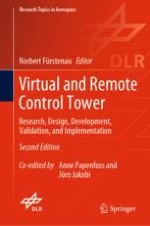2022 | OriginalPaper | Chapter
Designing a Low-Cost Remote Tower Solution
Authors : Fabian Reuschling, Jörn Jakobi
Published in: Virtual and Remote Control Tower
Publisher: Springer International Publishing
Activate our intelligent search to find suitable subject content or patents.
Select sections of text to find matching patents with Artificial Intelligence. powered by
Select sections of text to find additional relevant content using AI-assisted search. powered by
